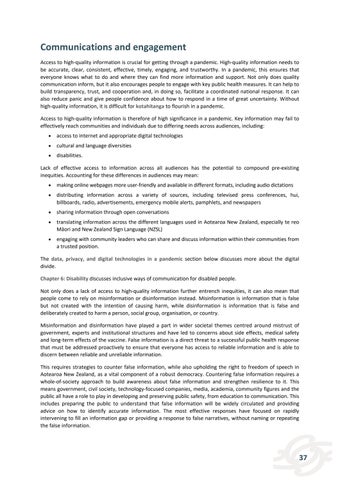Communications and engagement Access to high-quality information is crucial for getting through a pandemic. High-quality information needs to be accurate, clear, consistent, effective, timely, engaging, and trustworthy. In a pandemic, this ensures that everyone knows what to do and where they can find more information and support. Not only does quality communication inform, but it also encourages people to engage with key public health measures. It can help to build transparency, trust, and cooperation and, in doing so, facilitate a coordinated national response. It can also reduce panic and give people confidence about how to respond in a time of great uncertainty. Without high-quality information, it is difficult for kotahitanga to flourish in a pandemic. Access to high-quality information is therefore of high significance in a pandemic. Key information may fail to effectively reach communities and individuals due to differing needs across audiences, including: •
access to internet and appropriate digital technologies
•
cultural and language diversities
•
disabilities.
Lack of effective access to information across all audiences has the potential to compound pre-existing inequities. Accounting for these differences in audiences may mean: •
making online webpages more user-friendly and available in different formats, including audio dictations
•
distributing information across a variety of sources, including televised press conferences, hui, billboards, radio, advertisements, emergency mobile alerts, pamphlets, and newspapers
•
sharing information through open conversations
•
translating information across the different languages used in Aotearoa New Zealand, especially te reo Māori and New Zealand Sign Language (NZSL)
•
engaging with community leaders who can share and discuss information within their communities from a trusted position.
The data, privacy, and digital technologies in a pandemic section below discusses more about the digital divide. Chapter 6: Disability discusses inclusive ways of communication for disabled people. Not only does a lack of access to high-quality information further entrench inequities, it can also mean that people come to rely on misinformation or disinformation instead. Misinformation is information that is false but not created with the intention of causing harm, while disinformation is information that is false and deliberately created to harm a person, social group, organisation, or country. Misinformation and disinformation have played a part in wider societal themes centred around mistrust of government, experts and institutional structures and have led to concerns about side effects, medical safety and long-term effects of the vaccine. False information is a direct threat to a successful public health response that must be addressed proactively to ensure that everyone has access to reliable information and is able to discern between reliable and unreliable information. This requires strategies to counter false information, while also upholding the right to freedom of speech in Aotearoa New Zealand, as a vital component of a robust democracy. Countering false information requires a whole-of-society approach to build awareness about false information and strengthen resilience to it. This means government, civil society, technology-focused companies, media, academia, community figures and the public all have a role to play in developing and preserving public safety, from education to communication. This includes preparing the public to understand that false information will be widely circulated and providing advice on how to identify accurate information. The most effective responses have focused on rapidly intervening to fill an information gap or providing a response to false narratives, without naming or repeating the false information.
37


